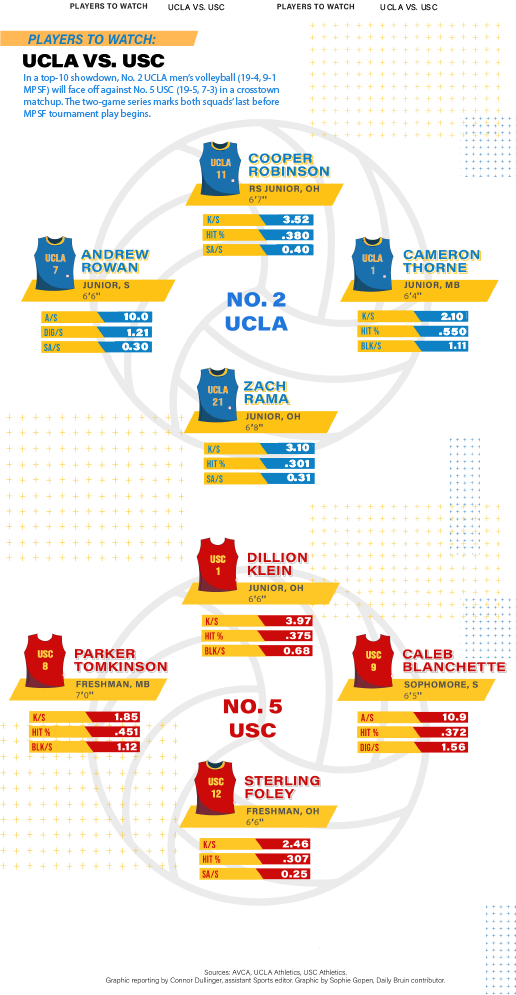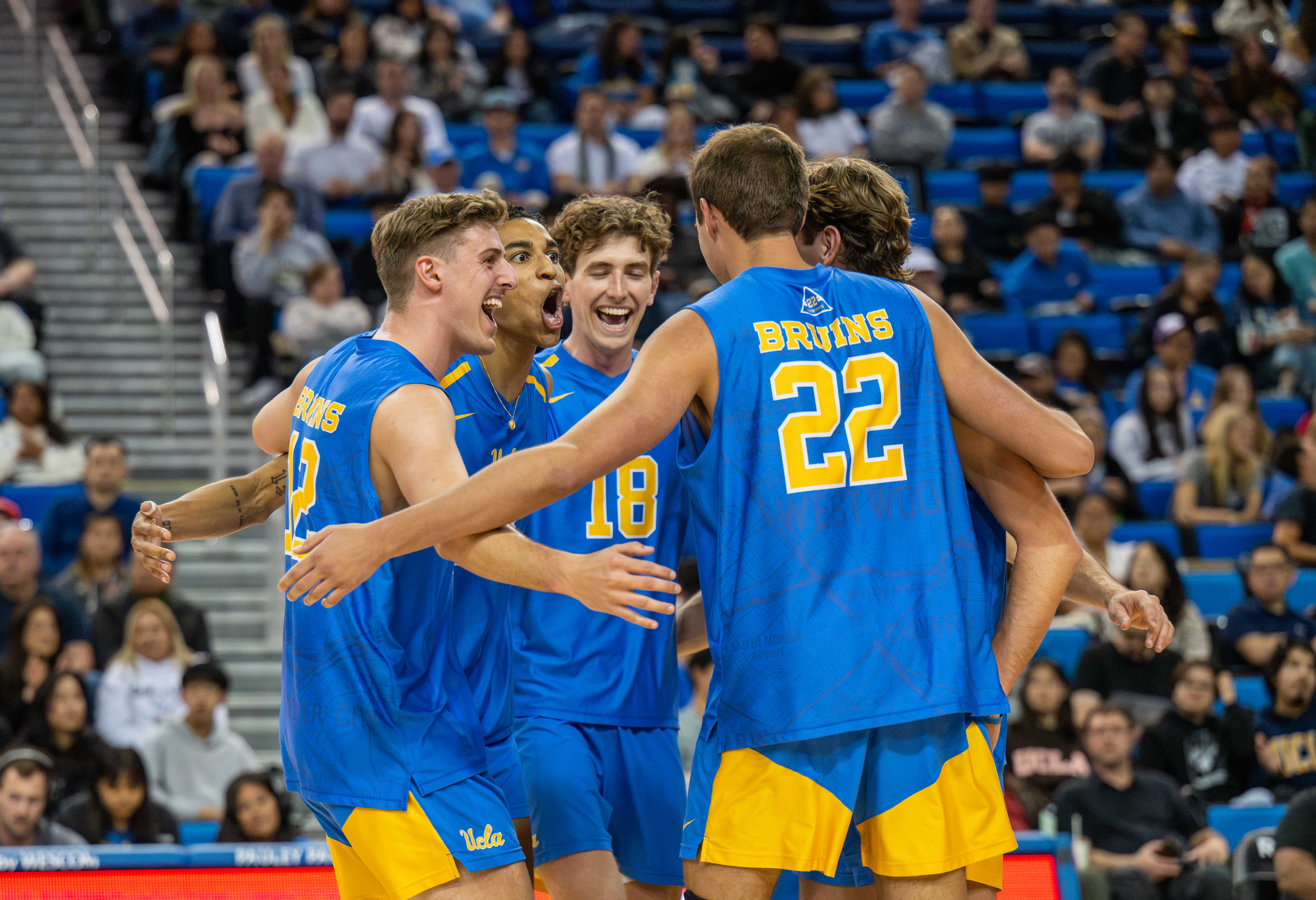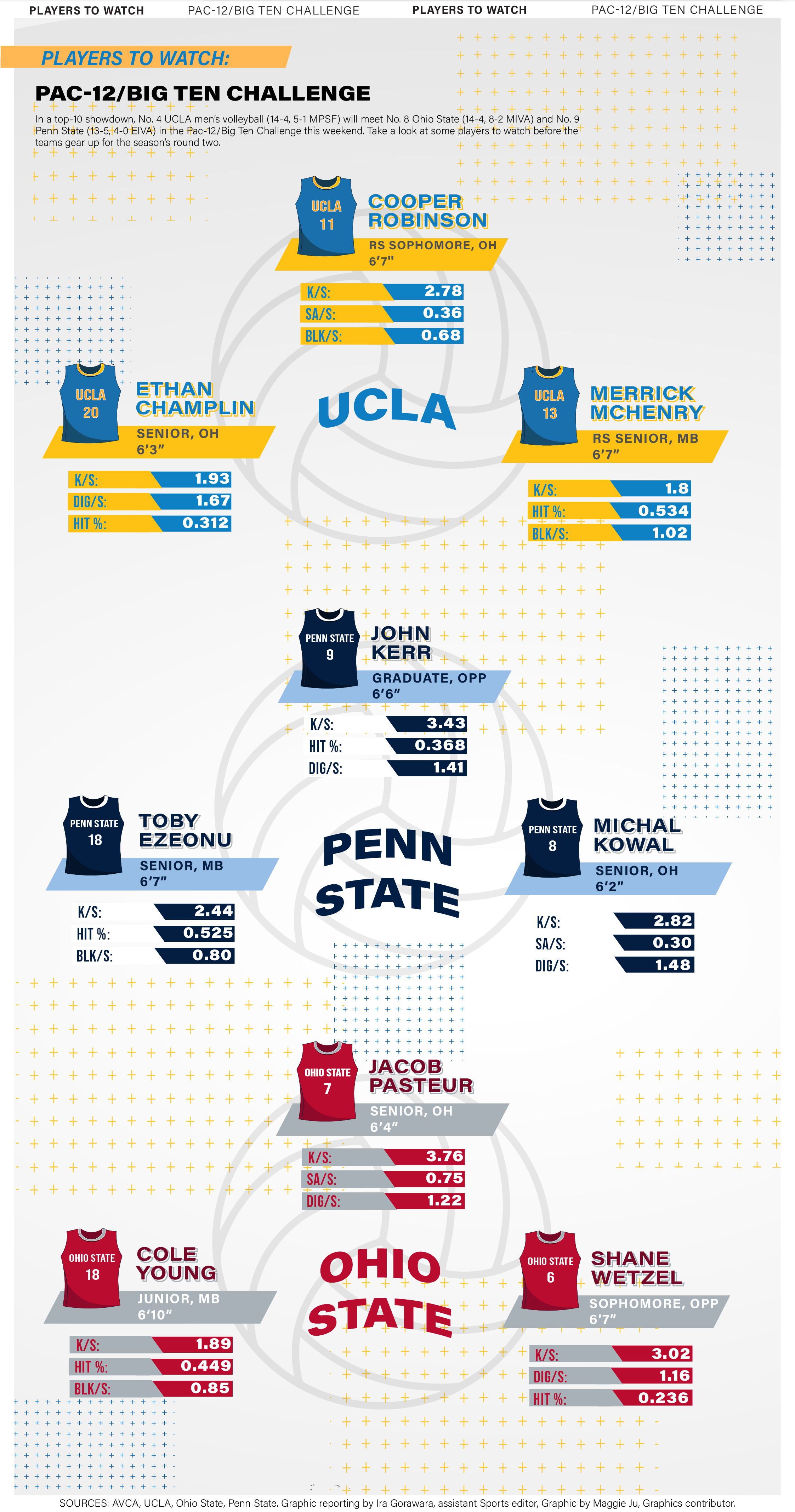Scouting report: UCLA men’s volleyball vs. USC

By Grant Walters
April 16, 2025 8:17 p.m.
No. 2 UCLA men’s volleyball (19-4, 9-1 MPSF) will have a chance to extend its seven-game win streak in the Battle for LA against No. 5 USC (19-5, 7-3 MPSF) on Thursday at Pauley Pavilion – which is also senior night – and Saturday evening at the Galen Center. USC heads into the matchup on a three-game losing streak, recently dropping back-to-back contests against Stanford, while UCLA rides a three-game win streak. The crosstown series will dictate the MPSF regular season winner: USC must win both games to take the top spot, whereas UCLA needs just one victory to clinch the No. 1 seed. Here is this rivalry scouting report from Daily Bruin contributor Grant Walters, who is excited to watch the Detroit Pistons – his favorite NBA team – play in the NBA Playoffs for the first time since 2019.
USC
Coach: Jeff Nygaard
Starting lineup: S Caleb Blanchette, OPP Luke Hobus, OH Dillon Klein, MB Parker Tomkinson, MB Guy Genis, OH Sterling Foley, L Johnny Dykstra
Strength: Blocking and Defense
Weakness: Serving and Inexperience
X-Factor: Parker Tomkinson
A middle blocker is the anchor of a team’s defense.
Cementing the team’s block and mitigating opponents’ pin hitters fall under the duties of a middle; therefore, it is often the position’s height that stands out.
At seven feet tall, middle blocker Parker Tomkinson passes the eye test.
The Carlsbad, California, local has been a dominant force at the net, registering a team-leading 92 blocks – good for 1.12 blocks per set – which ranks 10th best in the nation. And despite the Trojans’ three consecutive defeats, Tomkinson has continued to excel, sporting 26 blocks across the team’s last five contests.
Tomkinson and former UCLA middle blocker Guy Genis – who transferred to USC this past offseason – have formed a prolific blocking duo that has spearheaded the nation’s top-ranked squad in blocks per set. Complementing the freshman’s defensive prowess, the 2022 AVCA Second Team All-American also registers 1.03 blocks per set.
The duo’s ability to stifle opposing attacks has contributed to the Trojans’ No. 22 ranking in opponent hitting percentage at .235. However, USC will be tasked with limiting UCLA’s relentless attack, an arsenal that has garnered the second-best hitting percentage in the NCAA at a .367 clip.
Junior middle blocker Cameron Thorne will be lined up opposite of Tomkinson and Genis. The 2024 AVCA First Team All-American registered a combined 18 kills and 10 blocks in the Bruins’ recent series against BYU and ranks 11th in the nation in blocks per set with a 1.11 clip.
At Grand Canyon last season, Thorne dominated the net against USC, tying a season-best 14 kills on a .765 hitting percentage while also posting six blocks to lead his team to a four-set victory.
But despite Thorne’s play, the height of Tomkinson may stymy him.
Standing at 6-foot-4, Thorne’s undersized stature for the position forces the junior to rely on his explosive ability to command the Bruins’ defense, and he has yet to face an opposing seven footer this season.
UCLA head coach John Hawks may give redshirt junior middle blocker Sean McQuiggan – who stands at 6-foot-11 – an opportunity to showcase his skillset and height to combat Tomkinson.
McQuiggan has played in less than half of UCLA’s games; however, he had his best series of the season against BYU last week – accumulating a combined 10 blocks across both games to match Thorne’s series total.
Although the Trojans command an imposing block, it is their ability to keep the ball off the ground that provides their defensive foundation. USC ranks 19th in digs per set with a 9.08 clip, ranking ahead of the other four teams in the top five of the AVCA National Collegiate poll. And although USC has a talented freshman at the front end, it is freshman libero Johnny Dykstra that shores up USC’s back end.
The defensive specialist boasts a team-leading 175 digs, helping him secure 2.30 digs per set, which ranks 13th in the nation. Compared to his dig total, Dykstra has committed just 23 reception errors, posting a 7.61 dig-to-reception error ratio.
However, it is past the back line where the Trojans struggle: serving has been a consistent issue.
USC ranks outside of the top 50 in aces per set, sitting at just a 1.0 clip, and opposing teams have converted 93 aces compared to USC’s total of 92.
But the same can be said for the Bruins, who post a nation-leading 526 service errors. However, the Trojans’ lack of service line production has contributed to their 0.29 ace-to-service error ratio, a slightly worse clip than the Bruins’ 0.32, despite only committing 314 service errors.
USC’s primary serving option is freshman outside hitter Sterling Foley, who leads the team with 21 aces, garnering 0.25 per set. The lack of precise hitters from the service line has forced the Trojans to enable a more cautious approach, which differs from the Bruins’ more aggressive approach.
Thus, more pressure is placed on their defense to compensate for the team’s inability to control the pace of the match from the service line.
Against the Bruins – who average just 1.44 reception errors per set while bolstering 12.54 kills per set – the Trojans’ timid service arsenal may limit the team’s formidable defense to enforce its will on the contest, especially with the Bruins’ relentless yet composed attack.
Although games are often won on defense or at the service line, experience is also key.
And the Trojans lack just that.
Four out of USC’s seven players in the starting lineup are underclassmen, and three of these underclassmen are freshmen.
Compared to USC’s youth, UCLA only has upperclassmen in its starting lineup, each of whom have national championship experience.
UCLA has leaned heavily on its veteran leaders this season, fostering a 10-game winning streak after back-to-back losses against Long Beach State on Feb. 7 and Feb. 12, respectively.
And yet again, UCLA will need to rely on its experience to pierce a tenacious USC defense.




